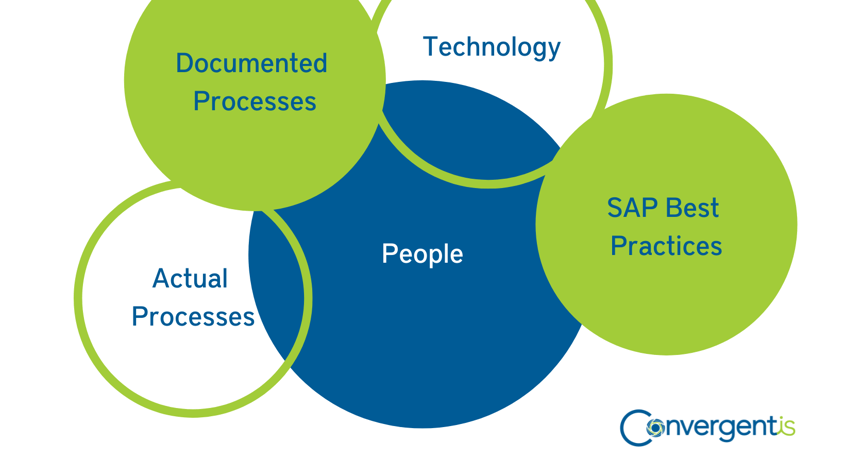When looking at deploying new SAP products, we can be quick to think we are making a comparison between different technologies and subscriptions. However, IT departments have quickly realized the question isn’t the what, but rather the who. User experience might have once been overlooked by IT departments; but as transformations continued to fail, organizational change management continues to bring to light tools that are nothing without adoption from the people who use them. As a result, IT transformations have become increasingly dependent on its end users and how people work. This means not only will your business need to find the technology that solves your predefined business case, it will also need to consider what teams are currently using it for and how this will change. Pretty soon, the number of factors that determine what the best SAP solution for your business is will have grown quite lengthy and complicated.
To simplify the decision-making matrix made by IT leaders, we have compiled the most critical factors in a transformation and distilled them down to the basics. Using this list as a reference, you will be well on your way to assigning proper weight to each, and ensuring your team loves the tools they are using.

Creating the Best SAP Solution
To ensure your business is making a transformation that will deliver a healthy return on investment (ROI), it is essential to find the intersection between people (your users), processes (how your people work), and technology (SAP). Upon closer inspection, the intersection of three areas can be broken down a little bit further to ensure your business is implementing the best SAP solution available.
These five factors are:
SAP Technology: Even within the SAP ecosystem, there are many applications, interfaces, and platforms to choose from. This means depending on your business needs and your current infrastructure there are many choices to be made even among out-of-the-box software.
SAP Best Practices: SAP promotes different offerings that can be used in conjunction with each other and makes recommendations about how a tool can be better optimized. Following the best practices can at times help your business get the most out of a tool.
Documented Business Processes: The set of policies and procedures that are viewed as the best practice for how a task or process should be completed within your organization. Think about the compliance binder you received on your first day.
Actual Business Processes: The processes your team is actually using to complete day-to-day tasks.
People: The technology users that allow your business to grow, thrive and function, often with the day-to-day availability to conduct tasks and business processes in your organization.
A couple of things might stand out in this list; one, technology is not the only factor that the IT and business processes team should be considering. This may run contrary to the belief that with every new product that hits the market, your business must deploy rapidly, or risk being left behind. Additionally, this list separates actual and documented business processes.
The Best SAP Solution Depends on People
Although we link people, processes, and technology, like SAP we are primarily a people company. This is because it is people that use technology, and people who have the ability to drive a business forward. Technology is simply a tool that enables people to perform their jobs better. In turn, jobs that are performed better will result in a company that is operating more efficiently and achieving a greater ROI.
Focusing on people is a benefit for another reason too. That is, it helps your organization remain adoption focused. This is important because if people don’t love the tools, they use to do their jobs, they won’t want to use the tools at all and any hope of your business achieving a fundamental change with technology is lost. Even if your business invests in the latest and greatest innovation, users could easily continue in the old way of doing things if it is easier for them. The bottom line? When it comes to people and technology, your business should focus on your people.
Actual vs. Documented Business Processes
The second distinction that should be highlighted is that the circle of processes should be considered as two distinct factors, not one. In most cases, actual and documented business processes are not the same. Consider that your policies binder might outline the process for completing a purchase order as inputting information using the ME21N code, filling out the blanks listed, and submitting it. However, users who don’t use SAP often might decide it is easier to fill out the PO (Purchase Order) on paper and give it to the purchasing team or their administrative assistant to input for them. This might not be of concern, since the result is the task is being completed even if it does lack efficiency.
In this example, as people look for workarounds, the likelihood of mistakes to be made has increased. A documented PO created manually that requires input into SAP can get lost in a shuffle on the desk and may never get inputted into SAP. Additionally, the purchasing team or an administrative assistant will have other responsibilities, that when coupled with their day-to-day tasks may result in bottlenecks, efficiencies or human input errors.
A solution to this workaround then needs to consider both the documented process of what should happen and what is happening to determine the best SAP solution to solve the problem.
The ConvergentIS Approach
To consider these factors as you progress through your search, try to visualize a Venn Diagram where the largest circle is people. Surrounding it are each of the factors listed above: SAP technology, SAP best practices, documented business processes, and actual processes. There is no perfect intersection between all these practices. It is dependent on each business and its workflows. However, if your users are at the center, balancing the rest of these factors will begin to fill the gaps.
For more information on our approach to creating the best SAP solutions, we encourage you to read more about how we work.

